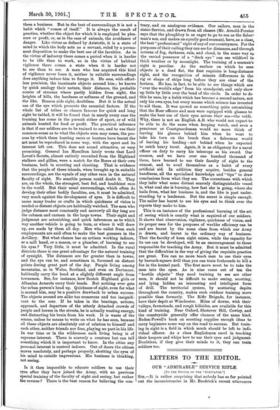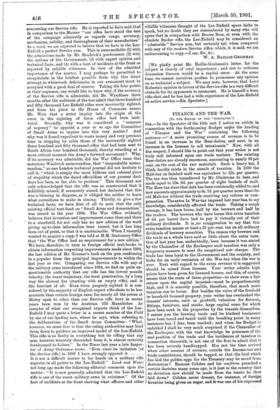LETTERS TO THE EDITOR.
OUR " ADMIRABLE " SERVICE RIFLE.
[TO TIIE EDITOR OF THE "SPECTATOR."]
STR,—It is rather surprising that nobody has so far pointed out the inconsistencies in Mr. Brothick's recent utterances concerning our Service rifle. He is reported to have said that in comparison to tbe Manger "our rifles have stood the test of the campaign admirably as regards range, accuracy: mechanism, solidity, and thoroughness of their manufacture.' In a word, we are expected to believe that we have in the Lee- Enfield a perfect Service arm. This is irreconcilable (1) with the admissions made by Mr. Brodriek's predecessor, (2) with the actions of the Government, (3) with expert opinion and technical facts, and (4) with a host of incidents at the front as reported by reliable witnesses. In view of the admitted importance of the matter, I may perhaps be permitted to recapitulate in the briefest 'possible form why this latest attempt to whitewash deficiencies in our armament must be accepted with a good deal of reserve. Taking the four points in their sequence, one would like to know why, if the accuracy of the Service rifle, is admirable, did Mr. Wyndham three months after the outbreak of the war admit that three hundred and fifty thousand Lee-Enfield rifles were incorrectly sighted, and from his place in the House of Commons assure Mr. Weir that a strict inquiry into the origin of the error in the sighting of these rifles had been insti- tuted. Secondly, why was it considered a "measure of urgency "• to appoint a year or so ago the Committee of Small Arms to inquire into this very matter? And why was it found expedient to waste money and very precious time in stopping by cable those of the incorrectly sighted three hundred and fifty thousand rifles that had been sent to South Africa (one hundred thousand), thereby retarding at a most critical moment the Army's forward movement? Why, if its accuracy was admirable, did the War Office issue that notorious Woolwich memorandum, that "unspeakable memo- randum," as one London technical journal did not hesitate to call it, "which is simply the most hideous and colossal piece of stupidity which the dazed officialdom of our present dark days has been, so fax, able to produce." This document not only acknowledged that the rifle was so constructed .that it infallibly missed, if accurately aimed, but declared that this was a blessing in disguise, as it obliged the soldier to learn what corrections to make in aiming. Thirdly, to give a few technical facts, we have first of all to note that the only existing official text-book on "Small Arms and Ammunition" was issued in the year 1894. The War Office evidently believes that invention and improvement came then and there to a standstill, for not only has no new edition of the work giving' up-to-date information been issued, but it has long been out of print, so that it is unobtainable. When I recently wanted to acquire a copy, I was told at H.M. Stationery Office that "the War Office had no requirement for a new edition." We have, therefore, to turn to foreign official text-books to obtain information respecting improvements made since 1894, the last edition of Mr. Greener's book on the gun confirming in a popular form the principal improvements to within the last year or two. Comparing our Service rifle with any of the military arms introduced since 1894, we find on quite un- questionable authority that our rifle has the lowest muzzle velocity, the worst trajectory, the least penetration, bj a long way the slowest fire (starting with an empty rifle), and is the heaviest of all. Even-when properly sighted it is con- sidered by the.majority of English expert rifle-shots to be leas accurate than certain foreign ones, for nearly all the prizes at Bisley open to other than our Service rifle have in recent years been won by the Austrian .256 Mannlicher. As samples of what our recognised experts think of the Lee- Enfield I may quote a letter in a recent number of the Field by one of our leading men, where he says, when referring to the deliberations of the Small Arms Committee : "What, however, we must fear is that the ruling authorities may bind them down to produce an improved model of the Lee-Enfield.' This rifle is so faulty in everything but its rifling that any arm, however remotely descended from it, is almost certainly .foredoomed to failure." In the Times last year a late Inspec- tor of Army Ordnance wrote: "Ever since its initiation [of
the Service rifle] in 1888 I have strongly opposed it It is not a difficult matter to lay hands on a military rifle superior in all points to the Lee-Enfield." Land and Water not long ago made the following editorial comment upon the matter : "It is now generally admitted that the Lee-Enfield rifle is one of the worst military arms in existence." Of the host of incidents at the front showing what officers and other
• reliable witnesiei thought -of the Lee-Enfield space licks" to speak, but no doubt they are remembered by many who will agree that in comparison with- Brown Bess, or even with the obsolete Snider rifle, the Lee-Enfield may be considered an " admirable " Service arm, but certainly not when compared with any of the modern Service rifles, which, it is said, we are endeavouring to copy.—I am, Sir, &c.,
W.£ BirLuE.Gnonzur.
[We gladly, print Mr. Baillie-Grohman's letter, for the subject is clearly of vital importance ; and not to welcome discussion thereon would be a capital error. At the same time, we cannot ourselves profess to pronounce any opinion on so technical a subject. We may note, however, that Lord Roberts's opinion in favour of the Service rifle is a very difficult obstacle for its opponents to surmount. He is himself a keen rifle-shot, and he has had a wide experience of the Lee-Enfield on active service.—En. Spectator.]







































 Previous page
Previous page